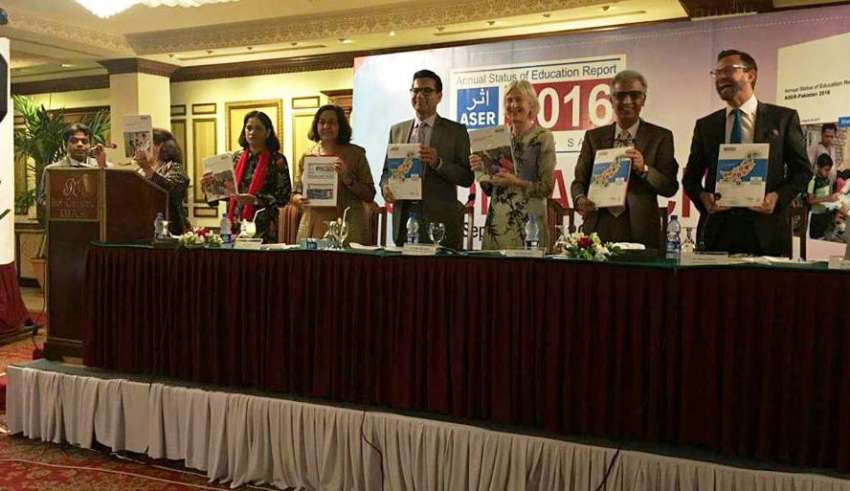
KARACHI: According to the Sindh Annual Status of Education Report (ASER) rural survey 2016 there has been a two percent increase in the enrolment of children aged 6-16 years since 2015. This is significant for Sindh to honour Article 25 A or right to education and its rules notified in 2016 and ready to be rolled out; 22% children aged 6-16 still remain out of school. Of those enrolled, 88 percent are going to public sector/government schools and 12 percent to non-state facilities that includes all private schools, madrassas and non=formal programs. Of a major concern to the citizen led learning accountability initiative is 78% who are enrolled in the 6-16 age bracket their learning outcomes remain tragically poor, leading to high vulnerabilities. The Government of Sindh’s leadership bravely acknowledged the challenges wowing to address them through systems and scale and partners
These findings were made public in the report of Pakistan’s largest-annual citizen-led household based ASER Survey 2016 – the seventh ASER Survey report in a row – launched in Karachi on Wednesday / 26/09/2017. ASER is managed by Idara-e-Taleem-o-Aagahi (ITA) in partnership with many key civil society and semi-autonomous bodies including theNational Commission for Human Development (NCHD). CSOs viz. DCHD, HANDS, HWA Foundation and SSYDO.
Teams of volunteers visited 25 districts and 718 villages to collect information from 14,237 households and 43,488 children of age 3-16 years. For the year 2016, the ASER rural survey assessed 37,150 children of 5-16 year age cohort in Language (Urdu/Sindhi/Pashto), English, and Arithmetic competencies of lower primary level (grades 2/3) . ASER uses learning, household and school based tools for the survey to render a full picture of the child’s learning and living conditions a one on one oral assessment of children at the household level.
The report informs the progress or lack thereof with respect to Article 25 A of the constitution making education a fundamental right for 5-16 year old children since 2010 and also for tracking progress towards SDG 4.1 measuring learning at the lower primary level. The ASER 2016 Sindh Report was released by the Chief Guest, Honourable Education & Literacy Minister Sindh, Jam Mehtab Dahar and eminent panelists including the Secretary School Education & Literacy Department Aziz Ahmed Uqaili. Both the leaders promised active reforms across the province on : teacher recruitment (9000), guide or subject based teacher trainers and mentors recruitment (6000) for training clusters of 10 schools (4 km radius across Sindh) to improve quality in English, Maths, Science and Social Studies; up gradation of schools at the post primary levels, handing over underperforming schools to Education Management Organizations (EMOs), active and diligent action oriented monitoring by DG Monitoring and Evaluation (DGM&E) teams and fast track implementation of ECE. Just like improvement in teachers presence up to 90% province wide, both the Minister and Secretary promised province wide transformative reforms in the next 3-6 months for early wins and a five year program for a complete turn around.
Proportion of out-of-school children has decreased as compared to 2015. In 2016, 22% of children were reported to be out-of-school as compared to 24% for 2015. This is good news but a tough road ahead to meet the SDG 4 goal and targets that have been fully endorsed by the Government of Pakistan and the province of Sindh. The province has been actively aligning its sector plan to the promise made both for SDG 4 (12 years of schooling) and Sindh Right of Children to Free and Compulsory Education Act in 2013.
Early Childhood Education has also been tracked by ASER. ECE enrolment reveals a mixed trend i.e. from 41% in 2013 to 37% in 2014, 2015 and 38% in 2016. ECE is foundational to all learning that can be easily accelerated in SIndh where Policy, standards, teaching cadre, systems and start up financing in the budgets is in place, but implementation remains very slow.
ASER 2016 -Sindh reveals student competencies in learning English, Arithmetic, and Language have dipped compared to 2015. 63% of the children from Class V cannot read Class II level story text in Urdu/Sindhi/Pashto. In English, only 19% of the surveyed Class V students could read sentences, which should ideally be read by students from the second grade. Arithmetic learning levels also have gone down where only 24% of class V children could do a two-digit division, something that is expected in second grade curriculum. ASER Pakistan 2016 (rural) reveals highest learning levels in AJK, ICT, Punjab, KP, with lower and lowest in FATA, Balochistan and Sindh.
Private sector albeit small in terms of enrolment (12%) (facilities wise 9.5%) in Sindh continues to outperform Public Sector in Learning. Children enrolled in private schools are performing better than those in government schools; 59% children enrolled in Class-V in private schools were able to read a story in Urdu/Sindhi/Pashto compared to 35% Class V students studying at government schools. The difference in learning levels is starker for English, where 56% Grade V could read English Class II level sentences compared to 15% public sector students! For arithmetic 54% children enrolled in class V and going to private school can do 2-digit division as compared to 22% government school children enrolled in class V! In some provinces this gap may be getting narrower; however the private sector edge is a consistent feature. This is corroborated by other studies too in Pakistan. In Sindh one out of 4 children in private sector are also taking coaching/tuitions compared to only 9$ in public sector.
Boys outperform girls: the survey highlights hat boys are outperforming girls in literacy and numeracy skills. As many as 34% of boys were found able to read at least sentences in Urdu/Sindhi/Pashto as compared to 25% girls. For Arithmetic, 32% of Class V boys were able to do Class II level subtraction as compared to only 24% Class V girls. Whilst enrolment gaps have narrowed slightly(1-2%), the learning gaps for girls and especially the poorest remain very high.
School Functioning in Sindh. In addition to the assessment of children, the report highlights school functioning across every district in Sindh. The ASER rural survey informs that over all teachers’ attendance in government schools stood at 86% as compared to 88% in private schools on the day of the survey. For MA/MSC or post graduate qualifications, larger percentage of public sector teachers have a higher qualification than private sector counterparts whilst for graduate level qualifications the private sector has a higher proportion 48% compared to 45% in government schools.. What is the role of qualifications compared to attitudes and pedagogies? PR











